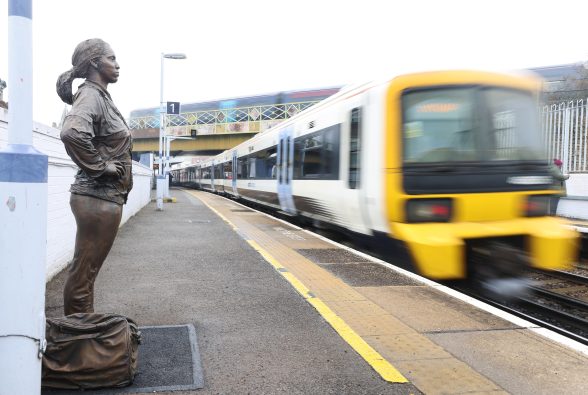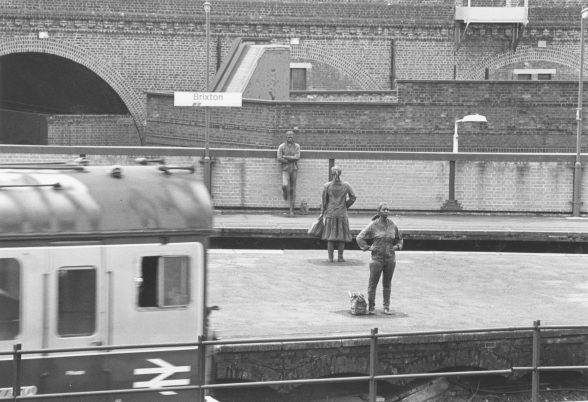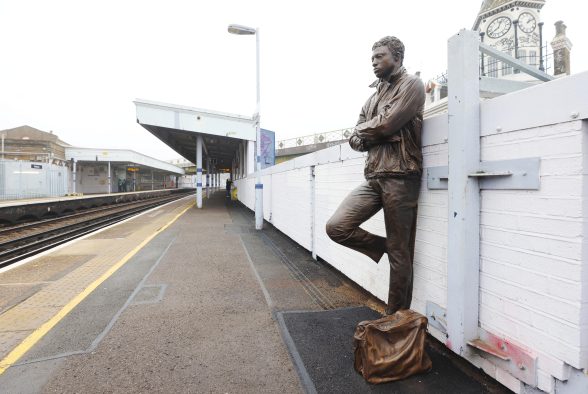This website uses cookies
This website uses cookies to enable it to function properly and to analyse how the website is used. Please click 'Close' to accept and continue using the website.



Image: Network Rail
C20 has applied for a listing amendment on a group of historic 1980s sculptures in Brixton, South London. Platforms Piece was created in 1985-86 by artist Kevin Atherton, and consisted of three life-sized figures in bronze, of passengers standing on the platforms at Brixton railway station. The group was Grade II listed in 2016, with two of the figures thought to be the first public sculptural representation of black British people in the UK.
The three figures were joined by a fourth in 2023, after one of the original subjects, Joy Battick, posed again for Atherton some 35 years on. The new sculpture stands on the opposite platform facing her 26 year old self, and it is this additional figure the Society has requested be included within the list description, believing it increases the artistic interest and strengthens the historic significance of the overall piece.
The artwork was commissioned by British Rail as part of the larger Brixton Station Improvement Scheme, with Atherton selected by a panel including noted architect and designer Sir Hugh Casson. The three, free-standing bronze figures represented people with particular connections to Brixton: Peter Lloyd, Joy Battick and Karin Heistermann. Lloyd and Battick are both Black Britons and Heistermann is a white German woman, and all were living in South London.

Image: Network Rail
The figures were removed for restoration in 2022 and reinstalled in January 2023. In the intervening period between 1986 and the sculptures’ restoration, one of the railway lines at Brixton station was taken out of operation, leaving the figure of Joy Battick hidden and inaccessible. Atherton lobbied British Rail to relocate the figure to another platform at the station, while commenting “she needs somebody to look at”. The decision was taken to recast Joy, creating a new figure, Joy II – “Joy will be looking at her younger self”, the artist said, “that same bag at her feet, across the platform, the trains going on…”
Like the 1980s figures, Joy II is a free-standing, roughly life-sized bronze sculpture. In the ‘80s, Atherton body-cast the three figures, but for Joy II he decided to use modern technology, working with a 360-degree bank of scanners and cameras to produce a 3D model, which was then cast in bronze. The two figures adopt the same confident pose, standing with feet apart, hands on hips, looking straight ahead.

Image: Network Rail
Black British cultural heritage
The original sculpture was installed just five years after the 1981 Brixton riot which saw conflict between the Black community and the Metropolitan Police. The riot was one of several episodes of civil unrest occurring in the early 1980s in response to economic inequality and institutional racism suffered by Black and multi-ethnic communities. Atherton’s sculpture was intended to stand in the centre of Brixton as a monument to its Black residents. Reflecting on the listing of Platforms Piece, Atherton declared that “Historic England should be commended for recognising the piece as a celebration of the cultural identity of the area”.
In an interview at the Butler Gallery in summer 2022, Atherton explained that “It’s an island platform, so it means there’s a kind of pier down the centre […] I body-cast three people to stand on the platforms and I positioned them in a straight line in order to emphasise their stillness, their waiting, and the trains went in between. So there were two people looking at one another and the third person [Joy Battick] is looking beyond the platform.”
The sculpture overlooks the Brixton Recreation Centre (1985), which was also Grade II listed in 2016. It was listed partly for its ‘cultural importance’ as “a social centre for the community, much-valued in the locality and the site chosen by Nelson Mandela as part of his historic state visit in 1996 in the area most synonymous with post-war black British culture” and for its association with Platforms Piece, “which also reflects Brixton’s cultural identity”. Both Peter Lloyd and Joy Battick worked at the Brixton Recreation Centre in the 1980s. Platforms Piece, the Brixton Recreation Centre and Ian Walters’ bust of Nelson Mandela on London’s South Bank were a group of ‘new black history listings’ announced in 2016 by Historic England in 2016 as part of a contribution to the BBC’s Black and British season.

Image: Network Rail
The Artist
Kevin Atherton is an artist and art educator, known for his performance and video art and sculpture. A number of Atherton’s more recent artworks explore the idea of revisiting older pre-existing work. This was explored in an exhibition, ‘The Return’ at the Butler Gallery (which ran from the 6 August-2 October 2022), which showcased work where ““he [Atherton] ‘re-enters’ his previous works and through his interventions re-animates and adds to or alters their previous meaning”. The exhibition included a maquette of Joy II facing the original Joy sculpture.
In a recent interview, Atherton compared Joy II to his earlier work In Two Minds. In Two Minds originated in 1978 as a video performance at the Project Arts Centre in Dublin. Atherton recorded a series of questions-to-camera which he then answered live in front of an audience the same evening. He remade the work for the Serpentine Gallery in London (1978) as a two-monitor installation with the recorded questions on one monitor and the recorded answers on the other, the two monitors facing one another across the space. Atherton then remade the work several times in the early 2000s and most recently in 2014, for the Irish Museum of Modern Art.

Image: Network Rail

Become a C20 member today and help save our modern design heritage.